HTC IRIS100 Smart Phone User Manual Book Iris Generic English Manual indb
HTC Corporation Smart Phone Book Iris Generic English Manual indb
HTC >
Contents
- 1. User manual 1
- 2. User manual 2
- 3. User manual 3 rev
User manual 1

Smart
User Manual

2
Please Read Before Proceeding
THIS DEVICE IS NOT FULLY CHARGED WHEN YOU TAKE IT OUT OF THE BOX.
DO NOT REMOVE THE BATTERY PACK WHEN THE DEVICE IS CHARGING.
YOUR WARRANTY IS INVALIDATED IF YOU OPEN OR TAMPER WITH THE DEVICE’S OUTER
CASING.
PRIVACY RESTRICTIONS
Some countries require full disclosure of recorded telephone conversations, and stipulate that you must
inform the person with whom you are speaking that the conversation is being recorded. Always obey the
relevant laws and regulations of your country when using the recording feature of your Smartphone.
INTELLECTUAL PROPERTY RIGHT INFORMATION
Copyright © 2006 High Tech Computer Corp. All rights reserved.
, , , ExtUSB are trademarks and/or service marks of High Tech Computer Corp.
Microsoft, MS-DOS, Windows, Windows NT, Windows Server, Windows Mobile, ActiveSync, Excel, Internet
Explorer, MSN, Hotmail, Outlook, PowerPoint, Word, and Windows Media are either registered trademarks or
trademarks of Microsoft Corporation in the United States and/or other countries.
Bluetooth and the Bluetooth logo are trademarks owned by Bluetooth SIG, Inc.
microSD is a trademark of SD Card Association.
Java, J2ME and all other Java-based marks are trademarks or registered trademarks of Sun Microsystems, Inc.
in the United States and other countries.
Copyright © 2006, Adobe Systems Incorporated.
Copyright © 2006, Macromedia Netherlands, B.V.
Macromedia, Flash, Macromedia Flash, Macromedia Flash Lite and Reader are trademarks and/or registered
trademarks of Macromedia Netherlands, B.V. or Adobe Systems Incorporated.
Copyright © 2006, JATAAYU SOFTWARE (P) LTD. All Rights Reserved.
Copyright © 2006, Tao Group Limited. All Rights Reserved.
Copyright © 2006, Tegic Communications. T9 and XT9 are trademarks or registered trademarks of Tegic
Communications. XT9 Mobile Interface is licensed under one or more of the following: U.S. Pat. Nos.5,187,480,
5,818,437, 5,945,928, 5,953,541, 6,011,554, 6,286,064, 6,307,548, 6,307,549, and 6,636,162, 6,646,573,
6,970,599, 6,801,190, 7,030,863, 7,088,345; Australia Pat. Nos.
727539, 746674, 747901; Austria Pat. Nos. AT225534, AT221222; Brazil P.I. No. 9609807-4; Canada Pat.
Nos. 1,331,057, 2,227,904, 2,278,549, 2,302,595; Japan Pat. Nos. 3532780, 3492981; United Kingdom Pat.
No. 2238414B; Hong Kong Standard Pat. No. HK1010924; Republic of Singapore Pat. Nos. 51383, 66959,
71976, 89076; European Pat. Nos. 0 842 463 (96927260.8), 1 010 057 (98903671.0), 1 018 069 (98950708.2);
Republic of Korea Pat. Nos. KR201211B1, KR226206B1, 402252, 552085; People’s Republic of China Pat. No.
ZL96196739.0; Mexico Pat. Nos. 208141, 216023, 218409; Russian Federation Pat. Nos. 2206118, 2214620,
2221268; New Zealand Pat. No. 519928; and additional patents are pending worldwide.
Licensed by QUALCOMM Incorporated under one or more of the following patents:
4,901,307 5,490,165 5,056,109 5,504,773 5,101,501 5,778,338 5,506,865
5,109,390 5,511,073 5,228,054 5,535,239 5,710,784 5,267,261 5,544,196
5,267,262 5,568,483 5,337,338 5,659,569 5,600,754 5,414,796 5,657,420
5,416,797
3
All other company, product and service names mentioned herein are trademarks, registered trademarks or
service marks of their respective owners.
HTC shall not be liable for technical or editorial errors or omissions contained herein, nor for incidental or
consequential damages resulting from furnishing this material. The information is provided “as is” without
warranty of any kind and is subject to change without notice. HTC also reserves the right to revise the content
of this document at any time without prior notice.
No part of this document may be reproduced or transmitted in any form or by any means, electronic or
mechanical, including photocopying, recording or storing in a retrieval system, or translated into any
language in any form without prior written permission of HTC.
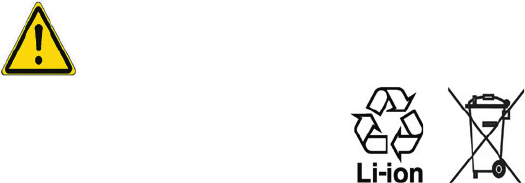
4
Important Health Information and Safety Precautions
When using this product, the safety precautions below must be taken to avoid possible legal liabilities and
damages. Additional safety information can be found in the Appendix at the end of the user manual.
Retain and follow all product safety and operating instructions. Observe all warnings in the operating
instructions on the product.
To reduce the risk of bodily injury, electric shock, fire and damage to the equipment, observe the following
precautions.
ELECTRICAL SAFETY
This product is intended for use when supplied with power from the designated battery or power supply unit.
Other usage may be dangerous and will invalidate any approval given to this product.
SAFETY PRECAUTIONS FOR PROPER GROUNDING INSTALLATION
CAUTION – Connecting to an improperly grounded equipment can result in an electric shock to your device.
This product equipped with a USB Cable for connecting with desktop or notebook computer. Be sure your
computer is properly grounded (earthed) before connecting this product to the computer. The power supply
cord of a desktop or notebook computer has an equipment-grounding conductor and a grounding plug. The
plug must be plugged into an appropriate outlet which is properly installed and grounded in accordance with
all local codes and ordinances.
SAFETY PRECAUTIONS FOR POWER SUPPLY UNIT
• Use the correct external power source
A product should be operated only from the type of power source indicated on the electrical ratings label.
If you are not sure of the type of power source required, consult your authorized service provider or local
power company. For a product that operates from battery power or other sources, refer to the operating
instructions that are included with the product.
• Handle battery packs carefully
This product contains a Li-Ion or Li-Ion Polymer battery. There is a risk of fire and burns if the battery
pack is handled improperly. Do not attempt to open or service the battery pack. Do not disassemble,
crush, puncture, short external contacts or circuits, dispose of in fire or water, or expose a battery pack to
temperatures higher than 60˚C (140˚F).
WARNING! Danger of explosion if battery is incorrectly replaced. To reduce risk of fire or burns, do not
disassemble, crush, puncture, short external contacts, expose to temperature above 60oC (140oF),
or dispose of in fire or water. Replace only with specified batteries. Recycle or dispose of used
batteries according to the local regulations or reference guide supplied with your product.
SAFETY PRECAUTIONS FOR DIRECT SUNLIGHT
Keep this product away from excessive moisture and extreme temperatures. Do not leave the product or
its battery inside a vehicle or in places where the temperature may exceed 60°C (140°F), such as on a car
dashboard, window sill, or behind a glass that is exposed to direct sunlight or strong ultraviolet light for
extended periods of time. This may damage the product, overheat the battery, or pose a risk to the vehicle.
5
PREVENTION OF HEARING LOSS
CAUTION – Permanent hearing loss may occur if earphones or headphones are used at high volume for
prolonged periods of time.
Turn down the volume before using headphones or other audio devices. An excessive sound volume level
could cause damage to your hearing.
SAFETY IN AIR CRAFT
Due to the possible interference caused by this product to an aircraft’s navigation system and its
communications network, using this device’s phone function on board an airplane is against the law in most
countries. If you want to use this device when on board an aircraft, remember to turn off your phone by
switching to Flight Mode.
ENVIRONMENT RESTRICTIONS
Do not use this product in gas stations, fuel depots, chemical plants or where blasting operations are in
progress, or in potentially explosive atmospheres such as fuelling areas, fuel storehouses, below deck
on boats, chemical plants, fuel or chemical transfer or storage facilities, and areas where the air contains
chemicals or particles, such as grain, dust, or metal powders. Please be aware that sparks in such areas could
cause an explosion or fire resulting in bodily injury or even death.
EXPLOSIVE ATMOSPHERES
When in any area with a potentially explosive atmosphere or where flammable materials exist, the product
should be turned off and the user should obey all signs and instructions. Sparks in such areas could cause
an explosion or fire resulting in bodily injury or even death. Users are advised not to use the equipment at
refueling points such as service or gas stations, and are reminded of the need to observe restrictions on the
use of radio equipment in fuel depots, chemical plants, or where blasting operations are in progress. Areas
with a potentially explosive atmosphere are often, but not always, clearly marked. These include fueling areas,
below deck on boats, fuel or chemical transfer or storage facilities, and areas where the air contains chemicals
or particles, such as grain, dust, or metal powders.
ROAD SAFETY
Vehicle drivers in motion are not permitted to use telephony services with handheld devices, except in the
case of emergency. In some countries, using hands-free devices as an alternative is allowed.
SAFETY PRECAUTIONS FOR RF EXPOSURE
• Avoid using your device near metal structures (for example, the steel frame of a building).
• Avoid using your device near strong electromagnetic sources, such as microwave ovens, sound
speakers, TV and radio.
• Use only original manufacturer-approved accessories, or accessories that do not contain any metal.
• Use of non-original manufacturer-approved accessories may violate your local RF exposure guidelines
and should be avoided.
INTERFERENCE WITH MEDICAL EQUIPMENT FUNCTIONS
This product may cause medical equipment to malfunction. The use of this device is forbidden in most
hospitals and medical clinics.
If you use any other personal medical device, consult the manufacturer of your device to determine if it
is adequately shielded from external RF energy. Your physician may be able to assist you in obtaining this
information.
Turn the phone OFF in health care facilities when any regulations posted in these areas instruct you to do so.
Hospitals or health care facilities may be using equipment that could be sensitive to external RF energy.
6
HEARING AIDS
Some digital wireless phones may interfere with some hearing aids. In the event of such interference, you may
want to consult your service provider, or call the customer service line to discuss alternatives.
NONIONIZING RADIATION
Your device has an internal antenna. This product should be operated in its normal-use position to ensure
the radiative performance and safety of the interference. As with other mobile radio transmitting equipment,
users are advised that for satisfactory operation of the equipment and for the safety of personnel, it is
recommended that no part of the human body be allowed to come too close to the antenna during operation
of the equipment.
Use only the supplied integral antenna. Use of unauthorized or modified antennas may impair call quality and
damage the phone, causing loss of performance and SAR levels exceeding the recommended limits as well as
result in non-compliance with local regulatory requirements in your country
To assure optimal phone performance and ensure human exposure to RF energy is within the guidelines set
forth in the relevant standards, always use your device only in its normal-use position. Do not touch or hold
the antenna area unnecessarily when placing or receiving a phone call. Contact with the antenna area may
impair call quality and cause your device to operate at a higher power level than needed. Avoiding contact
with the antenna area when the phone is IN USE optimizes the antenna performance and the battery life.
General Precautions
• Heed service markings
Except as explained elsewhere in the Operating or Service documentation, do not service any product
yourself. Service needed on components inside the device should be done by an authorized service technician
or provider.
• Damage requiring service
Unplug the product from the electrical outlet and refer servicing to an authorized service technician or
provider under the following conditions:
• Liquid has been spilled or an object has fallen into the product.
• The product has been exposed to rain or water.
• The product has been dropped or damaged.
• There are noticeable signs of overheating.
• The product does not operate normally when you follow the operating instructions.
• Avoid hot areas
The product should be placed away from heat sources such as radiators, heat registers, stoves, or other
products (including amplifiers) that produce heat.
• Avoid wet areas
Never use the product in a wet location.
• Avoid using your device after a dramatic change in temperature
When you move your device between environments with very different temperature and/or humidity ranges,
condensation may form on or within the device. To avoid damaging the device, allow sufficient time for the
moisture to evaporate before using the device.
NOTE When taking the device from low-temperature conditions into a warmer environment or from high-temperature
conditions into a cooler environment, allow the device to acclimate to room temperature before turning on the
power.
7
• Avoid pushing objects into product
Never push objects of any kind into cabinet slots or other openings in the product. Slots and openings are
provided for ventilation. These openings must not be blocked or covered.
• Mounting Accessories
Do not use the product on an unstable table, cart, stand, tripod, or bracket. Any mounting of the product
should follow the manufacturer’s instructions, and should use a mounting accessory recommended by the
manufacturer.
• Avoid unstable mounting
Do not place the product with an unstable base.
• Use product with approved equipment
This product should be used only with personal computers and options identified as suitable for use with your
equipment.
• Adjust the volume
Turn down the volume before using headphones or other audio devices.
• Cleaning
Unplug the product from the wall outlet before cleaning. Do not use liquid cleaners or aerosol cleaners. Use a
damp cloth for cleaning, but NEVER use water to clean the LCD screen.
8
Contents
Chapter 1 Getting Started 11
1.1 Getting to Know Your Phone and Its Accessories .................................... 12
1.2 Installing the Battery ................................................................................. 15
1.3 Installing a microSD Card .......................................................................... 15
1.4 Turning On and Off the Phone .................................................................. 15
1.5 The Home Screen ....................................................................................... 16
1.6 Programs on Your Phone ........................................................................... 16
1.7 Start Menu .................................................................................................. 18
1.8 Quick List .................................................................................................... 18
1.9 Entering Information ................................................................................. 18
1.10 Battery Information ................................................................................... 19
1.11 Status Indicators ........................................................................................ 21
Chapter 2 Using Phone Features 23
2.1 Using the Phone ......................................................................................... 24
2.2 Making a Call .............................................................................................. 24
2.3 Receiving a Call .......................................................................................... 26
2.4 In-Call Options ........................................................................................... 26
2.5 Additional Dialing Information ................................................................ 27
Chapter 3 Synchronizing Information with Your Computer 29
3.1 About Synchronization ............................................................................. 30
3.2 Using Microsoft Windows Mobile® Device Center ................................... 30
3.3 Installing and Using Microsoft ActiveSync® ............................................ 31
3.4 Synchronizing with Your Computer ......................................................... 31
3.5 Synchronizing via Bluetooth .................................................................... 32
3.6 Synchronizing Music and Video ............................................................... 33
Chapter 4 Managing your Phone 35
4.1 Personalizing your Phone ......................................................................... 36
4.2 Adding and Removing Programs ............................................................. 40
4.3 Using Task Manager and Managing Memory .......................................... 40
4.4 Managing and Backing Up Files ............................................................... 41
4.5 Protecting your Phone .............................................................................. 42
4.6 Restarting your Phone .............................................................................. 43
4.7 Resetting your Phone ................................................................................ 43
9
Chapter 5 Organizing Phone Information 45
5.1 Contacts ..................................................................................................... 46
5.2 Calendar ..................................................................................................... 47
5.3 Tasks ........................................................................................................... 48
5.4 Voice Notes ................................................................................................. 49
Chapter 6 Exchanging Messages 51
6.1 Messaging .................................................................................................. 52
6.2 Text Messages ............................................................................................ 52
6.3 MMS Messages ........................................................................................... 53
6.4 Setting Up E-mail Accounts ....................................................................... 55
6.5 E-mail Messages ......................................................................................... 57
Chapter 7 Working with Company E-mails and
Meeting Appointments 61
7.1 Synchronizing Your Phone with Your Company E-mail Server ............... 62
7.2 Working with Company E-mails ............................................................... 62
7.3 Managing Meeting Requests .................................................................... 65
7.4 Finding Contacts in the Company Directory ........................................... 66
7.5 E-mail Security ........................................................................................... 67
Chapter 8 Getting Connected 71
8.1 Comm Manager .......................................................................................... 72
8.2 Connecting to the Internet ....................................................................... 72
8.3 Internet Explorer Mobile ........................................................................... 74
8.4 Wi-Fi ........................................................................................................... 75
8.5 Bluetooth .................................................................................................... 76
8.6 Using your Phone as a Modem ................................................................. 79
8.7 Windows Live Mobile ................................................................................. 85
Chapter 9 Experiencing Multimedia 89
9.1 Camera and Video Recorder ..................................................................... 90
9.2 Pictures & Videos ....................................................................................... 93
9.3 Windows Media Player Mobile ................................................................. 94
9.4 Java ............................................................................................................. 97
Chapter 10 Using Other Applications 101
10.1 Microsoft® Office Mobile ......................................................................... 102
10.2 Microsoft® Office Word Mobile ............................................................... 102
10
10.3 Microsoft® Office Excel® Mobile .............................................................. 103
10.4 Microsoft® Office PowerPoint® Mobile ................................................... 106
10.5 Adobe Reader LE ...................................................................................... 107
10.6 Speed Dial ................................................................................................ 107
10.7 Voice Speed Dial ...................................................................................... 108
Appendix 111
A.1 Specifications ........................................................................................... 112
A.2 Regulatory Notices .................................................................................. 113
A.3 Additional Safety Information ................................................................ 118
Index 123

Chapter 1
Getting Started
1.1 Getting to Know Your Phone and
Its Accessories
1.2 Installing the Battery
1.3 Installing a microSD Card
1.4 Turning On and Off the Phone
1.5 The Home Screen
1.6 Programs on Your Phone
1.7 Start Menu
1.8 Quick List
1.9 Entering Information
1.10 Battery Information
1.11 Status Indicators
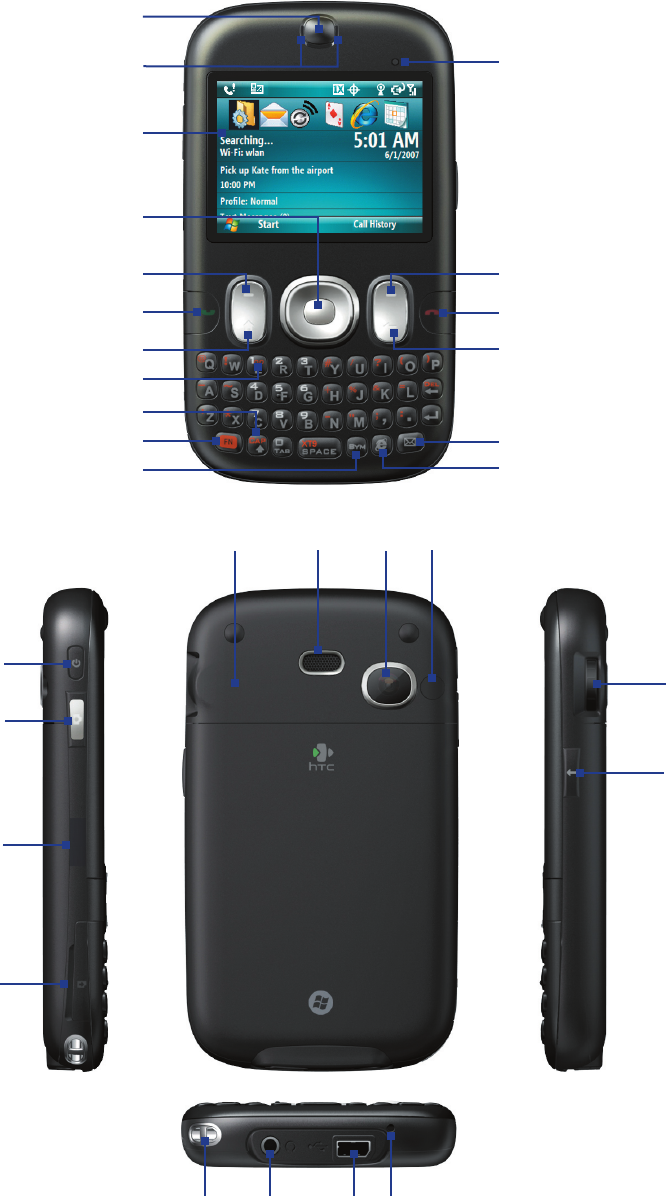
12 Getting Started
1.1 Getting to Know Your Phone and Its Accessories
2
3
4
5
6
7
10
12
1
11
13
9
8
14
15
16
17
18
26
19
21
28 29
20
27
22 2523 24
30 31

Getting Started 13
Item Function
1. Speaker Listen to phone call.
2. LED Indicators
The left LED indicator (green/red/amber) notifies you of the battery and network status of your phone,
while the right LED indicator (blue) notifies you of Bluetooth connectivity status. For more information
about LED Indicators, see the table at the end of this section.
3.
Display Screen
4.
NAVIGATION
CONTROL/ENTER Use to scroll left, right, up, or down. Press the center to use as the ENTER button..
5. Left SOFT KEY Press to perform the command shown in the label above the button.
6. TALK
Press to dial a phone number or answer a call. Press and hold to activate/deactivate speakerphone mode
.
7. HOME Press to go to the Home screen or press and hold to open Comm Manager.
8. Key Press and hold to retrieve your voice mails.
9. Key Press to type a single capital letter. Press the FN key then this key to type in all caps.
10. Key Press once to let you type symbols (characters in Amber) and enter numbers in text fields. Press twice for
continuous symbol or number entries.
11. Key Press to open the Symbol table (when typing text).
12. Key Press to open Internet Explorer Mobile.
13. Key Press to open Internet Explorer Mobile.
14. BACK Press to go back to the previous screen, or backspace over characters.
15. END Press to end a call, or press and hold to lock the phone keypad and the keyboard.
16.
Right
SOFT KEY Press to perform the command shown in the label above the button.
17.
Light Sensor
Sense dark conditions and activate a backlight under the keypad and the QWERTY keyboard
automatically, glowing in dark.
18. POWER
Press (about 3 seconds) to turn on and off the phone. Or press and quickly release the POWER button to
display the Quick List, which allows you to change profiles, open Comm Manager, and enable/disable
lock feature.
19. CAMERA Press and hold to open the Camera program. If already running, press to capture an image or start
recording a video clip.
20. Infrared Port Lets you exchange files or data with other devices wirelessly.
21. microSD Slot Insert a microSD memory card for storing data.
22. Back Cover Remove to insert or replace battery.
23. Speaker Listen to audio media or phone call when using speakerphone mode.
24. Camera lens 2.0 Megapixels camera lens.
25. Car Antenna
Connector Connect your phone to the car antenna while in a car to have better reception quality.
26. Jog Wheel
While on the Home screen or using applications, scroll up or down to navigate through menus or
program instructions; press the wheel to carry out a selection. During a call or while playing music, scroll
up or down to adjust the sound volume.
27. Back Button Press to go back to the previous screen, or backspace over characters.
28. Strap Holder Attach a strap for carrying your device.
29. Earphone/
Microphone Jack Connect a 2.5 mm stereo earphone to listen to audio media, or connect the phone’s hands-free kit.
30.
Sync Connector
Use for synchronizing data and recharging the battery.
31. Microphone Speak into the microphone when receiving or making a phone call or during voice recording.

14 Getting Started
LED indicator lights
Various colors that might display in the two LED Indicators are summarized here.
Left LED Status
Solid green Battery is fully charged.
Blank Battery case is empty or the phone is off.
Solid amber Battery is charging or the phone is using ActiveSync to synchronize with a PC.
Solid red Battery is not installed while the phone is charging/synchronizing or battery is over-discharged.
Flashing green Phone is connected to the network.
Flashing red Battery very low (less than 5%) or battery fault. Check if the battery is properly installed and its
exposed copper part is properly aligned with the protruding copper conductor of the phone body.
Right LED Status
Flashing blue Bluetooth mode set to “On” or “Visible” mode.
Flashing green Wi-Fi connected.
Accessories
The following accessories are provided with the phone:
Accessory Function
1. AC Adapter Recharges the battery.
2. USB Sync Cable Connects your device to a PC and synchronizes data.
3. Mini-USB Stereo
Headset
Provides a volume control slider and a Send/End button. Press the Send/End button to pick up a
call or put a call on hold; press and hold the button to end the call.
4. Pouch
Comes with belt clip. Store your device in the pouch to keep it away from dust and scratches..
5. 2.5 mm Stereo
Headset
Connect this headset to listen to audio media.
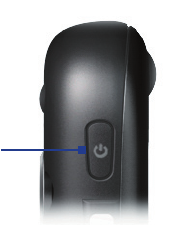
Getting Started 15
1.2 Installing the Battery
1. Slide the back cover to release it.
2. Insert the battery by aligning the exposed copper part of the battery pack with the protruding copper
conductor.
3. Gently push the battery into place.
4. Replace the back cover.
1.3 Installing a microSD Card
You can install a microSD (Secure Digital) card in your phone to have an alternative storage place for your
images, video, music, and other phone data.
• Pry open the rubber/fiber cover (if any) of the microSD slot on the side of the phone.
• Insert the microSD card into the slot with its gold contacts facing up.
To remove, press the microSD card to pop it out of the slot.
Note A microSD card is not included in the box.
1.4 Turning On and Off the Phone
Press and hold the POWER button for about 3 seconds to
turn on or off the phone.
POWER Button
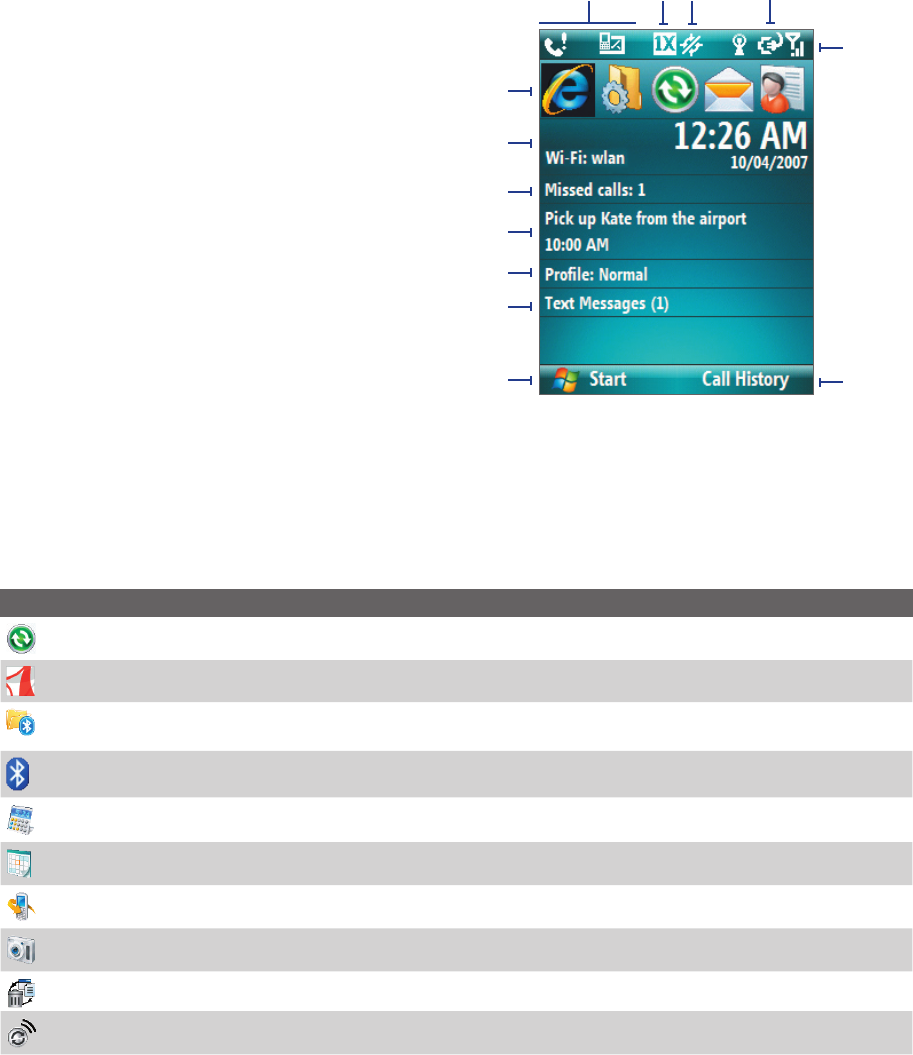
16 Getting Started
1.5 The Home Screen
The Home screen displays important information, such as upcoming appointments, status indicators, the
current date, time, and profile, and icons of programs that you have recently used. You can open a program
directly by selecting its icon and pressing ENTER.
• To access the Home screen from anywhere, press HOME.
• To customize the Home screen display, including the background, click Start > Settings > Home
Screen.
1. Select a recently-used program, and open it directly
from the Home screen.
1
2
3
4
5
6
7
12
13
8 9 10 11
Home Screen
2. Displays the name of your wireless service provider, Wi-
Fi connectivity status, current date, and time.
Click to open Comm Manager.
3. Click to view the details of a missed call.
4. Click to view the details of your next appointment.
5. Displays the current Profile being used.
Click to change the current Profile.
6. Displays the new messages that you have received.
Click to open the Messages folder.
7. Click to display all program icons.
8. Displays notifications, such as missed calls or new
messages.
9. Displays the available network or connectivity status.
10. Displays the location settings.
11. Displays the power status.
12. Displays the network signal strength.
13. Click to open Contacts, Call History, or Messages.
1.6 Programs on Your Phone
The following table lists icons of the programs that are already installed on your phone.
Icon Program Description
ActiveSync Synchronizes information between your phone and PC.
Adobe Reader LE View PDF files.
Bluetooth Explorer Searches for other Bluetooth devices that have file sharing enabled and allows you to
access their Bluetooth shared folder.
Bluetooth Settings Allows you to configure Bluetooth settings.
Calculator Do basic arithmetic and calculations.
Calendar Keeps track of your appointments, and creates meeting requests.
Call History Keeps track of all phone calls made, received, and missed.
Camera Captures photos in various modes.
Clear Storage Clears the memory and restores the phone back to factory default settings.
Comm Manager A central switch where you can manage phone and connection settings.
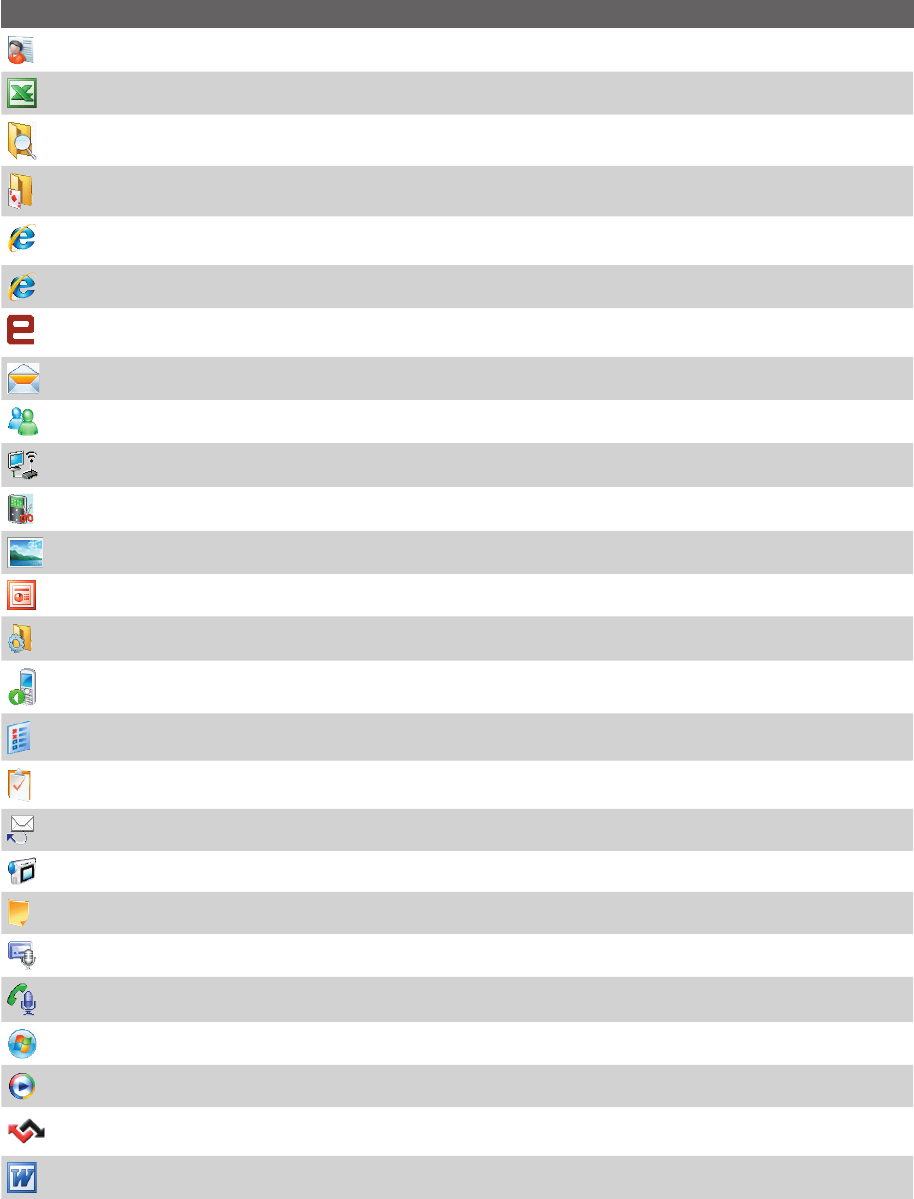
Getting Started 17
Icon Program Description
Contacts Keeps track of contact information.
Excel Mobile Lets you open, view, edit, and save Excel worksheets on your phone.
File Explorer Organize and manage files and folders.
Games Play two games: Bubble Breaker and Solitaire come with your phone.
Get Applications Links you to a web site where you can purchase and download programs that you can
install on your phone.
Internet Explorer Browse Web and WAP sites, and to download new programs and files from the Internet.
Java Download and install Java-based applications, such as games and tools, on your
phone.
Messaging Send and receive e-mails, MMS, and text messages.
Messenger Connect to the Windows Live Messenger service.
Modem Link Activates your phone as a modem for your PC.
MP3 Trimmer Trim an MP3 file to a desired length.
Pictures & Videos Collects, organizes, and sorts media files.
PowerPoint Mobile Lets you open, view, and save PowerPoint files on your phone.
Settings Personalize your phone to suit the way you use it.
Speed Dial Create speed dial entries for dialing frequently-called phone numbers or for opening
frequently-accessed programs.
Task Manager Keeps track of all running programs on your phone.
Tasks Keeps track of your tasks.
Text Messages Retry Ques and resends SMS messages that could not be delivered.
Video Recorder Captures video clips in various modes and duration.
Voice Notes Create short voice recordings.
Voice Recorder Record a voice clip and quickly send it over MMS.
Voice Speed Dial Lets you open a program or call a contact using voice recognition.
Windows Live Connect and use the Windows Live services.
Windows Media Player Play back video and audio files.
Wireless Sync
This software from Verizon Wireless allows you to synchronize and view e-mails and access
information, such as appointments, contacts, tasks, etc. that are stored on your phone
.
Word Mobile Lets you open, view, edit, and save Word documents and text files on your phone.
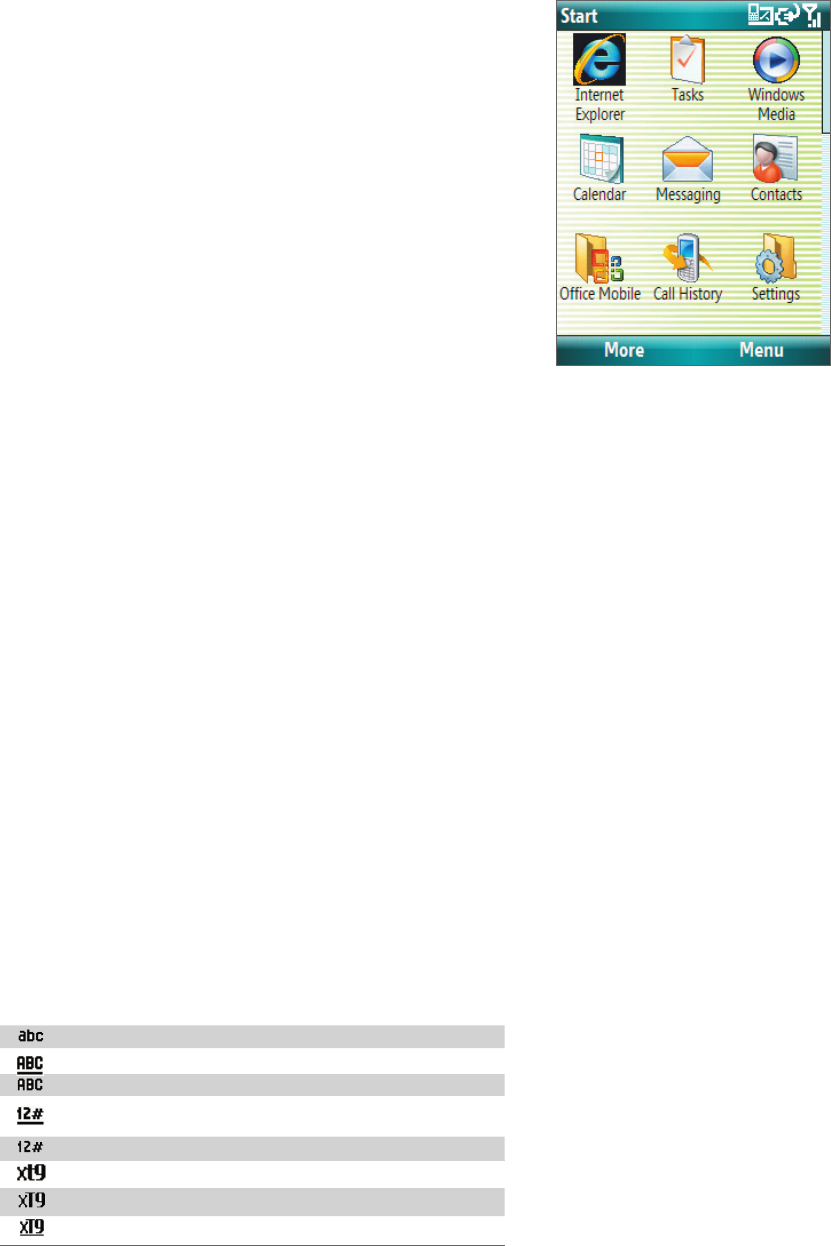
18 Getting Started
1.7 Start Menu
The Start menu is located at the bottom-left corner of the Home
screen and displays various program icons that are spread across
one or more screens.
To see the available programs in the Start menu
On the Home screen, click Start. To see more programs, click
More or use the NAVIGATION CONTROL.
Your phone comes with several bundled programs that you can
start using immediately. You can also install additional programs
from the included Windows Mobile® Getting Started Disc or from
the Internet, or purchase mobile phone software from retail
stores and install them on your phone.
Start menu
1.8 Quick List
The Quick List offers convenient access to a list of functions, such as locking your phone, and keyboard,
opening Comm Manager, and choosing a different profile. For more information about profiles, see Chapter 4.
To access the Quick List
1. Briefly press (press and quickly release) the POWER button. Please note that pressing and holding the
POWER button turns off the phone.
2. Scroll through the list and select the desired option. Then, do any of the following:
• Click Select.
• Press ENTER.
• Press the corresponding number on the QWERTY keyboard.
3. To exit the Quick List at any time, click Cancel.
1.9 Entering Information
You can enter text, numbers, and symbols using the QWERTY keyboard. When you select a field that requires
entering text or numbers, the phone automatically selects the appropriate input mode.The status indicator
on the top-right side of the display screen displays the input mode that you are currently using.
Lowercase text input
Uppercase text input, caps lock
Uppercase text input
Numeric or symbol (labeled in blue color) input, locked
(Keyboard only)
Numeric or symbol (labeled in blue color) input
XT9 text input mode, lowercase
XT9 text input mode, uppercase
XT9 text input mode, caps lock

Getting Started 19
You can do the following with the QWERTY keyboard:
• To type lowercase letters, press the keys using your thumbs or fingers.
• To use all uppercase letters, press first and then press . To change back to all lowercase letters,
press these buttons again.
• To use a single uppercase letter, press and then press the corresponding key.
• To enter a number or symbol (labeled in green), press and then press the corresponding key.
• To open the Symbol table while entering text, press .
• Press and hold to access your voicemail. Your voicemail number must be set up for this to work. To
check, click Start > Settings > Phone > Call Options and check Voice mail number.
• Press to launch Internet Explorer Mobile.
• Press to launch Messaging.
Using XT9 mode
To form a word in XT9 mode, press the keys that contain the letters you want. As you enter letters, XT9
analyzes your keypresses and attempts to complete the word. XT9 also tries to predict your next word based
on previous sentences you have typed.
To enter text in XT9 mode
1. Press and then press .
2. On the menu, select XT9 English.
Note You can choose a different XT9 language (if available) by selecting Language, and then choosing the language you
want.
While typing, words will appear at the bottom of the screen. Use the NAVIGATION CONTROL to choose the
word you want to insert then press ENTER.
1.10 Battery Information
Battery performance depends on many factors, including your wireless service provider’s network
configuration, signal strength, the temperature of the environment in which you operate your phone, the
features and/or settings you select and use, items attached to your phone’s connecting ports, and your voice,
data, and other program usage patterns.
Battery life estimates (approximations):
• Talk time: Up to 3.5 hours
• Standby time: Up to 212 hours
• Playing WMV: Up to 8 hours
• Playing WMA: Up to 12 hours
WARNING! To reduce risk of fire or burns:
• Do not attempt to open, disassemble, or service the battery pack.
• Do not crush, puncture, short external contacts, or dispose of in fire or water.
• Do not expose to temperatures above 60˚C (140˚F).
• Replace only with the battery pack designated for this product.
• Recycle or dispose of used battery as stipulated by local regulation.
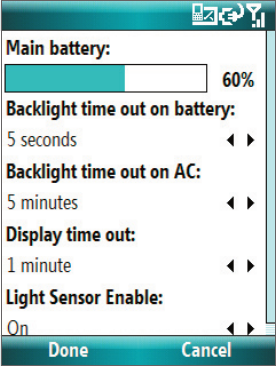
20 Getting Started
To check the battery power
• On the Home screen, click Start > Settings > Power Management.
To optimize the power performance
• On the Home screen, click Start > Settings >
Power Management, and adjust the backlight,
display, and light sensor settings.
To manage a low battery
When the low-battery warning appears, do the following:
1. Immediately save your current data.
2. Synchronize with your PC or use the AC adapter to charge the battery.
3. Turn off your phone. Turn it back on only when you need to use it.
Note If you turn off the Phone function when you are out of your network coverage area, the phone automatically goes
to the power-save mode and displays the following message:
Power-Saved Mode
Press any number key to exit
In this mode, your phone conserves the battery power. To quit this mode, press any number key on the keypad.
To charge the battery
New batteries are shipped partially charged. Before you start using your phone, it is recommended that you
install and charge the battery. Some batteries perform best after several full charge/discharge cycles.
You can charge the battery in two ways:
• Connecting your phone directly to an external power source with the AC adapter.
• Connecting your phone to a PC via the provided USB Sync cable or Splitter cable/adapter.
WARNING!
• Do not remove the battery from the phone while you are charging it using the AC adapter.
• As a safety precaution, the battery stops charging when it overheats.
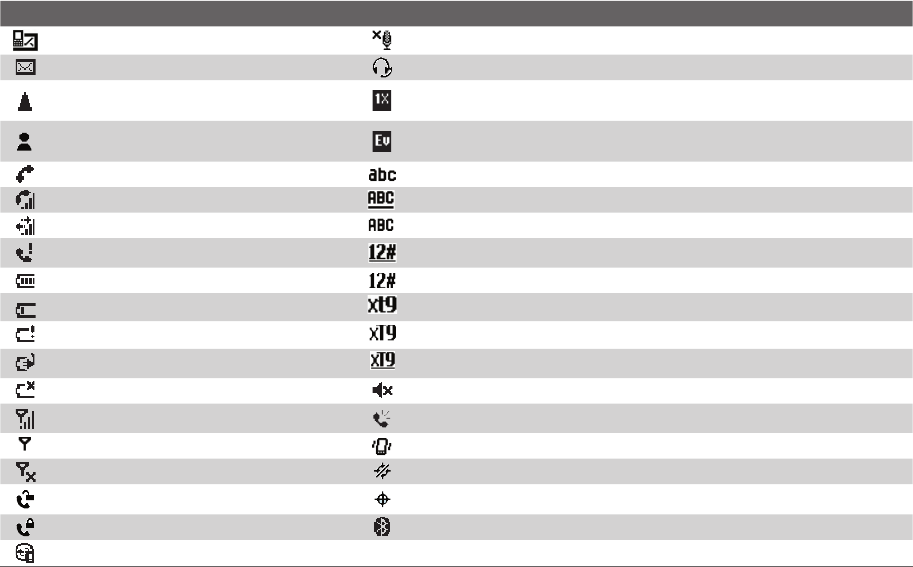
Getting Started 21
1.11 Status Indicators
The following table lists common status indicators with their description.
Icon Description Icon Description
New SMS message Microphone muted
New e-mail message
Bluetooth headset connected
Roaming 1xRTT available (1xRTT, 1 times Radio Transmission Technology, is
the third-generation data service)
New MSN Messenger message EVDO available (EVDO, Evolution Data Optimized, is a high speed
data service for wireless broadband and quick Internet access)
Incoming voice call Lowercase text input
Voice call in progress Uppercase text input, caps lock
Data call in progress Uppercase text input
Missed call Numeric or symbol (labeled in red color on keyboard) input, locked
Battery level Numeric or symbol input (labeled in red color on keyboard)
Low battery XT9 text input mode, lowercase
Very low battery
XT9 text input mode, uppercase
Battery charging XT9 text input mode, caps lock
No battery or battery fault Ringer off
Signal strength Speakerphone on
Radio connected or no signal Vibrate call alert
Radio off Location settings off
Voice privacy currently unavailable Location settings on
Voice privacy available and turned on Bluetooth On or Visible mode
Sync error
22 Getting Started

Chapter 2
Using Phone Features
2.1 Using the Phone
2.2 Making a Call
2.3 Receiving a Call
2.4 In-Call Options
2.5 Additional Dialing Information
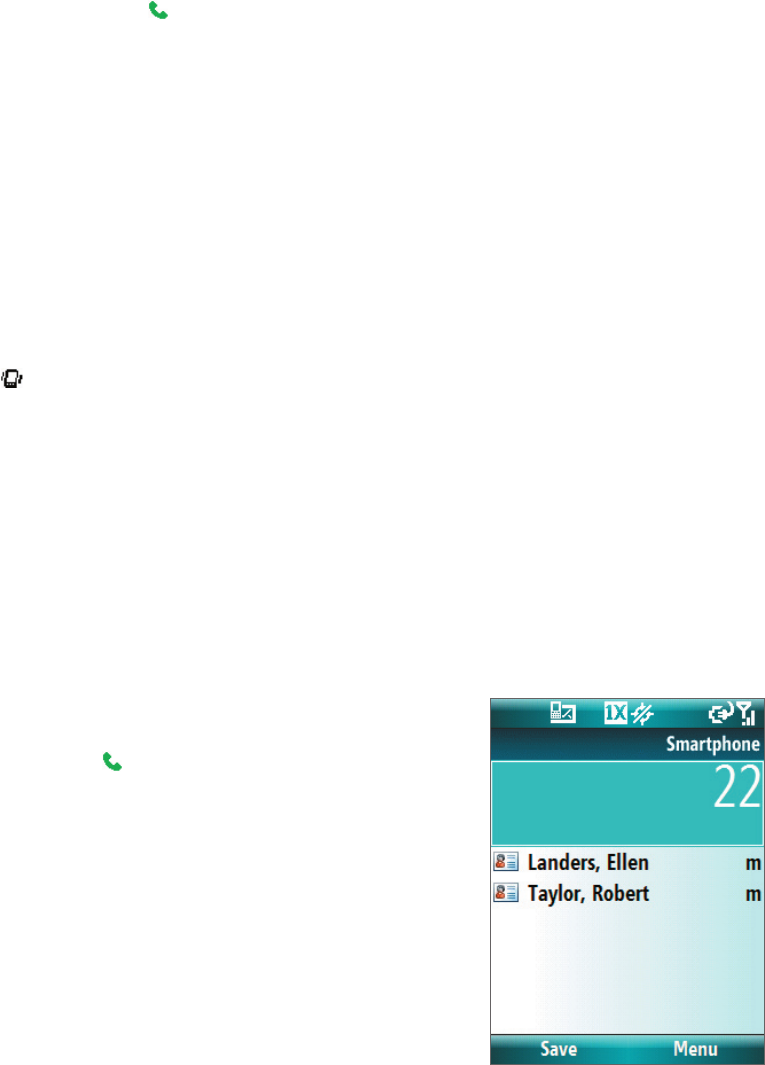
24 Using Phone Features
2.1 Using the Phone
You can use your phone to make, receive, and keep track of voice calls, and send text messages (SMS, Short
Message Service) and e-mail messages. You can also dial a phone number directly from Contacts.
Access the Phone screen
From the Phone screen, you can open, call, or find a contact, and even save a new number in Contacts. To
access the Phone screen, do any of the following:
• Press TALK ( ).
• Directly enter the phone number by pressing numeric keys on the phone keypad or the QWERTY
keyboard.
Set ring tones
You can choose how to be notified for incoming calls, reminders, new messages, alarms, and more.
To set a ring tone for incoming calls
1. On the Home screen, click Start > Settings > Sounds.
2. In the Ring tone list, select a ring tone.
3. Click Done.
If you select Vibrate, the sound is muted and the phone will vibrate when you receive a call. The Vibrate icon
( )
appears in the title bar. Selecting None in the Ring tone list mutes the phone. For more information about
sounds, see “Choose how to be notified about events or actions” in Chapter 4.
Note To adjust the earpiece volume during a call, use the volume adjustment slider on the phone's side panel. Adjusting
the volume at any other time can affect the ring, notification and MP3 sound levels.
2.2 Making a Call
With your phone, you can make calls from the Home screen, the Phone screen, from Contacts, Speed Dial, or
Call History.
Make a call from the Home screen
• Enter the phone number by pressing keys on the
phone keypad or the QWERTY keyboard, and press
TALK ( ).
Phone screen
• Press the BACK button or Del key if you need to
backspace.

Using Phone Features 25
Tip You will notice that when you press a key on the phone keypad or the QWERTY keyboard, a list of names and
numbers is displayed as your phone searches Contacts, Call History, and Speed Dial entries to find a matching
name or number. When you see the number or name of the
person you want to call, select it, and press TALK ( ).
Make a call from Contacts
1. On the Home screen, click Start > Calls > Contacts.
2. Select the desired contact, and press TALK ( ).
You can also select the desired contact in the contact list, and press the ENTER button twice (once to view the
contact details, and once to dial the associated number).
To specify the number to dial
By default, the mobile telephone number (m) of a contact is dialed when you make a call from Contacts;
however, you can choose to dial a different phone number.
1. On the Home screen, click Start > Calls > Contacts.
2. Select the contact.
3. Press NAVIGATION left or right. The letter representing the number changes to m (mobile), w (work), or
h (home).
You can also select a contact in the contact list, and press ENTER to view details and different numbers
associated with the contact. Select a number and press TALK ( ) or press ENTER to dial the number.
• You may also access the contact list by clicking Contacts on the Home Screen.
• To view or edit information associated with the selected contact, click Menu > Edit.
Make a call from Call History
1. On the Home screen, click Start > Calls > Call History.
2. Select a name or number, and press TALK ( ).
In the Call History screen, press ENTER to view details, such as the dialed, missed, or received call, call duration,
date, and time. Pressing ENTER again dials the associated number.
To customize calls
You can select various options on the Call History screen to customize and filter the calls made, received, or
missed.
• To find a name or number in Contacts, click Menu > Find Contact.
• To send a text message, click Menu > Send Text Message.
• To send an e-mail, click Menu > E-mail.
• To find the duration of a call, click Menu > View Timers.
• To remove a call or number from Call History, click Menu > Delete.
• To remove the list of calls or numbers from Call History, click Menu > Delete List.
• To save a name or number in Contacts, click Menu > Save to Contacts.
• To categorize the call or number into various call types, click Menu > Filter.
Note You can also save a number in Contacts by clicking Save on the Call History screen.
Make a call from Speed Dial
You can make calls using Speed Dial. To learn how to use Speed Dial, see “Speed Dial” in Chapter 10.
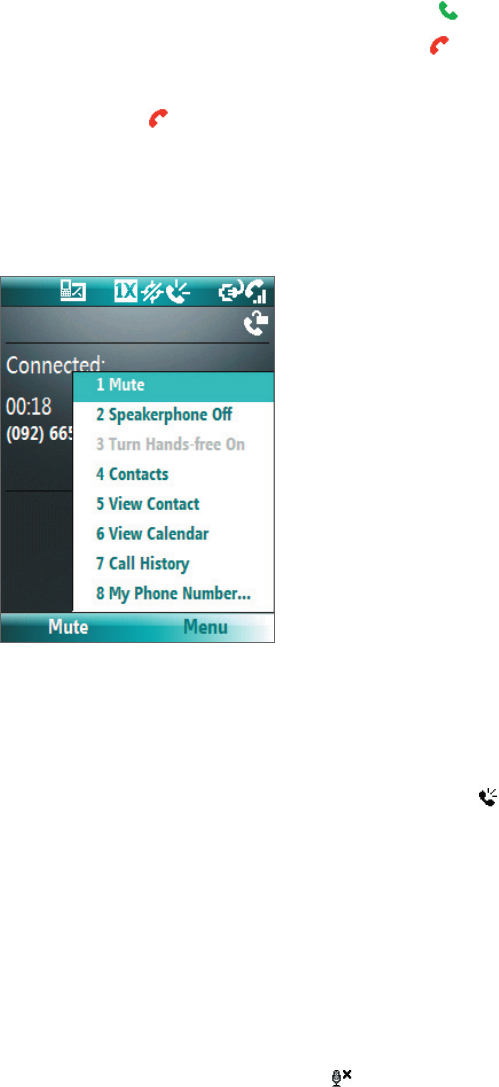
26 Using Phone Features
2.3 Receiving a Call
When you receive a phone call, you have the option to answer it or ignore it.
To answer or ignore an incoming call
•
To answer the call, click Answer, or press TALK ( ).
• To ignore the call, click Ignore, or press END ( ).
To end a call
• Press END ( ).
2.4 In-Call Options
Your phone provides various options for managing calls. During a call, you can use the loudspeaker mode,
mute or unmute your voice, or access Contacts, Calendar, and Call History for reference.
In-Call options
To turn the speakerphone on and off
The built-in speakerphone allows you to talk hands-free or lets other people listen to the conversation.
• During a call, click Menu > Speakerphone On. The icon appears at the top of the screen.
• To turn off the Speakerphone during the call, click Menu > Speakerphone Off. Alternatively, the
speakerphone can be toggled on and off by pressing and holding TALK during the call.
WARNING! To avoid damage to your hearing, do not hold your phone against your ear when the Speakerphone is turned
on.
To mute a call
You can turn off the microphone during a call, so that you can hear the caller but the caller cannot hear you.
• During a call, click Menu > Mute.
When the microphone is turned off, the icon appears on the screen. Click Menu > Unmute to turn on the
microphone again.

Using Phone Features 27
2.5 Additional Dialing Information
Make an emergency call
• Enter the appropriate emergency number for your locale, and press TALK ( ).
Make an international call
1. Press and hold on the phone keypad until the + sign appears. The + replaces the international
prefix of the country that you are calling.
2. Enter the full phone number, and press TALK ( ). The full phone number includes country code, area
code (without the leading zero, if any), and phone number.
Insert a pause in a dialing sequence
Some international calls require a pause in the dialing sequence in order for the call to process successfully.
1. On the Home screen, click Start > Calls > Contacts.
2. Select the contact entry that contains the phone number in which you want to insert a pause, and
press ENTER to open the contact card.
3. Click Menu > Edit.
4. Position the cursor on the phone number where you want to insert a pause.
5. Click Menu > Insert Pause.
The letter “p” will appear in the number to indicate where the pause will occur in the dialing sequence.
6. Click Done.
Insert a longer pause in a dialing sequence
Some phone numbers may require a longer pause than the default pause in the dialing sequence. In these
cases, you can pause as long as you want, and manually continue the dialing sequence.
1. On the Home screen, click Start > Calls > Contacts.
2. Select the contact entry that contains the phone number in which you want to insert a longer pause,
and press ENTER to open the contact card.
3. Click Menu > Edit.
4. Position the cursor on the phone number where you want to insert a longer pause.
5. Click Menu > Insert Wait.
The letter “w” will appear in the number to indicate where the longer pause (wait) will occur in the
dialing sequence.
6. Click Done.
Note When you call a number that contains a longer pause, you must press TALK ( ) again to continue dialing.
28 Using Phone Features

Chapter 3
Synchronizing Information
with Your Computer
3.1 About Synchronization
3.2 Using Microsoft Windows Mobile®
Device Center
3.3 Installing and Using Microsoft ActiveSync®
3.4 Synchronizing with Your Computer
3.5 Synchronizing via Bluetooth
3.6 Synchronizing Music and Video
30 Synchronizing Information with Your Computer
3.1 About Synchronization
You can take information from your computer wherever you go by synchronizing them to your phone. The
following types of information can be synchronized:
• Microsoft Outlook® information, which include Outlook e-mail, contacts, calendar, tasks, and notes
• Media, such as pictures, music and video
• Favorites, which are the bookmarked links to your favorite web sites
• Files, such as documents and other files
Before you can synchronize, you need to install first the synchronization software to your computer. For
information on installing and using the synchronization software on your computer, see “Using Microsoft
Windows Mobile Device Center” and “Installing and Using Microsoft ActiveSync” in this chapter.
Ways to synchronize
After you have installed the synchronization software to your computer, synchronize your phone with your
computer by using one of the following:
• Connect and synchronize using the supplied USB sync cable.
Upon connecting the sync cable to your phone and your computer, the synchronization process starts
automatically.
• Connect and synchronize using Bluetooth.
You must first set up a Bluetooth partnership between your phone and your computer before you
can synchronize information between them using Bluetooth. For more information about setting up
a Bluetooth partnership, see chapter 8. For information about synchronizing through Bluetooth, see
“Synchronizing via Bluetooth” later in this chapter.
Note You can also synchronize Outlook e-mail, contacts, calendar, and tasks on your phone with the Exchange Server at your
work. For more information about setting up your phone to synchronize with the Exchange Server, see chapter 7.
3.2 Using Microsoft Windows Mobile® Device Center
Microsoft Windows Mobile® Device Center is the replacement for Microsoft® ActiveSync® on Windows
Vista™.
Set up synchronization between your phone and PC
1. Connect your phone to your PC. Windows Mobile Device Center configures itself and then opens.
2. On the license agreement screen, click Accept.
3. On the Windows Mobile Device Home screen, click Set up your device.
Note Choose Connect without setting up your device if you only want to transfer media files, check for updates, and
explore your phone but not sync Outlook information.
4. Select the information types that you want to synchronize then click Next.
5. Enter a device name for your phone and click Set Up.
When you finish the wizard, Windows Mobile Device Center synchronizes your phone automatically. Notice
that Outlook e-mails and other information will appear on your phone after synchronization.
Synchronizing Information with Your Computer 31
3.3 Installing and Using Microsoft ActiveSync®
Follow the steps below to install and set up ActiveSync 4.5 or later on Windows XP or other compatible
Windows systems.
Note For a list of compatible Windows systems, please go to
http://www.microsoft.com/windowsmobile/activesync/activesync45.mspx
Install and set up ActiveSync
1. Insert the Getting Started Disc into the disc drive on your PC.
2. Follow the on-screen instructions to install ActiveSync.
3. After installation is completed, connect your phone to your PC.
4. The Synchronization Setup Wizard automatically starts and guides you to create a synchronization
relationship. Click Next to proceed.
5. To synchronize your phone with your computer, clear the Synchronize directly with a server running
Microsoft Exchange Server check box then click Next.
6. Select the information types that you want to synchronize and then click Next.
7. Click Finish.
When you finish the wizard, ActiveSync synchronizes your phone automatically. Notice that Outlook e-mails
and other information will appear on your phone after synchronization.
3.4 Synchronizing with Your Computer
Connect your phone to your PC to synchronize the information between your phone and PC. While your
phone is connected, ActiveSync (or Windows Mobile Device Center on your PC) synchronizes every time you
make a change on either the PC or your phone.
You can also manually start and stop synchronization any time.
To start and stop synchronization when using ActiveSync
1. After connecting your phone to your PC, click Start > ActiveSync on your phone.
2. Click Sync to start synchronization.
To end synchronization before it completes, click Stop.
To change which information is synchronized
You can add or reduce the types of information to synchronize between your phone and PC.
1. Before changing synchronization settings on your phone, disconnect your phone from your PC.
2. On your phone, click Start > ActiveSync.
3. Click Menu > Options.
4. Select or clear the items you want to synchronize or not synchronize. If you cannot select a check box,
you might have to clear the check box for the same information type elsewhere in the list.
5. To customize settings for an item, select that item and click Settings. Settings are not available for all
items.
Note The check boxes of the Favorites, Files, Media, and OneNote items are always grayed out in ActiveSync Options on your
phone. You can only select or clear these items from Windows Mobile Device Center or ActiveSync on your computer.

32 Synchronizing Information with Your Computer
To synchronize with more than one computer
You can set up your phone to synchronize with more than one PC or with a combination of one or more
PCs and Exchange Server. When synchronizing with multiple computers, the items that you synchronize will
appear on all of the computers with which they are synchronized.
For example, if you have set up synchronization with two PCs (PC1 and PC2), which have different items, and
you synchronize Contacts and Calendar on your phone with both computers, the result is as follows:
Location New state
PC1 All Outlook contacts and calendar appointments that were on PC2 are now also on PC1.
PC2 All Outlook contacts and calendar appointments that were on PC1 are now also on PC2.
Phone All Outlook contacts and calendar appointments from both PC1 and PC2 are on your phone.
Notes • Outlook e-mail can be synchronized with only one computer.
• To stop synchronizing with one PC completely, click Menu > Options, click the computer name, then click Menu >
Delete.
To resolve ActiveSync connection problem
When the PC is connected to the Internet or a local network, in some cases, the PC may disconnect the
ActiveSync connection with your phone in favor of the Internet or network connection. If this happens, click
Start > Settings > Connections > USB to PC, then clear the Enable advanced network functionality check
box. This makes ActiveSync utilize a serial USB connection with your phone.
3.5 Synchronizing via Bluetooth
You can connect and synchronize your phone with the PC using Bluetooth.
To synchronize with a computer via Bluetooth
1. Set up the synchronization software (Windows Mobile Device Center or ActiveSync) on your computer
to use a Bluetooth connection. For more information, see the software Help on your computer.
2. On your phone, click Start > ActiveSync.
3. Make sure that Bluetooth on both your phone and the computer are turned on and set to visible mode.
For more information, see “Bluetooth” in chapter 8.
4. Click Menu > Connect via Bluetooth.
5. If this is the first time you have connected to this computer via Bluetooth, you must first complete the
Bluetooth wizard on your phone and set up a Bluetooth partnership between your phone and the
computer. For more information about creating a Bluetooth partnership, see “Bluetooth partnerships”
in chapter 8.
Notes • To preserve battery power, turn off Bluetooth when not in use.
• To connect and synchronize your phone with a computer via Bluetooth, your computer must have built-in Bluetooth
or installed with a Bluetooth adapter or dongle.
Synchronizing Information with Your Computer 33
3.6 Synchronizing Music and Video
If you want to carry your music or other digital media along with you while you travel, set up Microsoft
Windows Media Player on your computer to synchronize music and video with your phone.
Other than selecting the media information type in ActiveSync to be synchronized, all media synchronization
settings must be set in Windows Media Player. Before media can be synchronized, you must do the following:
• Install Windows Media Player Version 11 on the PC. (Windows Media Player 11 works only in Windows
XP or later versions).
• Connect your phone to the PC with a USB cable.
• Set up a sync partnership between the phone and Windows Media Player.
For more information about Windows Media Player on your phone, see “Windows Media Player Mobile” in
chapter 9.
34 Synchronizing Information with Your Computer

Chapter 4
Managing your Phone
4.1 Personalizing your Phone
4.2 Adding and Removing Programs
4.3 Using Task Manager and Managing Memory
4.4 Managing and Backing Up Files
4.5 Protecting your Phone
4.6 Restarting your Phone
4.7 Resetting your Phone
36 Managing your Phone
4.1 Personalizing your Phone
Set up the Home screen
The Home screen is your starting place for most tasks. You can gain access to all features and programs from
the Home screen.
The top of the Home screen displays icons for the programs that you have most recently used. The center of
the Home screen can display your next appointment, the number of new messages (voice mail, text, or e-mail)
that you have received, and other important information. When you click an icon or item on the Home Screen,
the associated program opens.
To customize the Home screen
1. On the Home screen, click Start > Settings > Home Screen.
2. In Home screen layout, Color scheme, Background image, and Time out, select the options you
want, and click Done.
To set a picture as the background
1. On the Home screen, click Start > Pictures & Videos.
2. Select the picture you want to set as the background. Click View or press ENTER for a larger view of the
image.
3. Click Menu > Use as Home Screen.
4. Use the NAVIGATION CONTROL to select the portion of the picture you want to use, and click Next.
Note If the picture fits the screen, this step is skipped
.
5. In Adjust the transparency, select a higher percentage for a more transparent picture or a lower
percentage for a more opaque picture.
6. Click Finish.
Set date, time, language, and other regional options
Your phone should already be set up with the regional settings that are appropriate for your locale.
To change regional settings
You can specify the language, locale, date and time style, as well as number and currency formatting options.
1. On the Home screen, click Start > Settings > Regional Settings.
2. In Language, select your preferred language.
3. In Locale, select the locale for the language you selected. The Locale option automatically changes the
format of the remaining options (such as date, time, and currency) according to the locale you specify.
4. Click Done.
Note
You must turn your phone off and on again for the changes to take effect.
To set the date and time
1. On the Home screen, click Start > Settings > Clock & Alarm > Date and Time.
2. In Time zone, select your time zone.
3. In Date, edit the month, day, or year.
4. In Time, edit the hour, minute, and second.
5. Click Done.
Managing your Phone 37
To display digital clock on Unlock message screen
You have the option to choose whether you want to view the current date and time while you unlock the
phone.
1. On the Home screen, click Start > Settings > Unlock Screen Clock.
2. Select the desired option for date and time, and click Done.
Choose how to be notified about events or actions
A profile is a group of settings that determine how your phone will alert you to incoming calls and events,
such as e-mail receipt notifications, alarms, or system events. A number of different preset combinations of
these settings are included with your phone. Each profile appears with a descriptive name.
To change the current profile
1. On the Home screen, click Profile: [Type]. For example, Profile: Normal.
2. Choose a new profile, and click Done.
Tip To quickly change the profile, briefly press POWER to display the Quick List, and choose a profile. You can also
change the profile by clicking Settings > Profiles from the Comm Manager screen.
To edit a profile
1. On the Home screen, click Profile: [Type]. For example, Profile: Normal.
2. Select the profile to edit.
3. Click Menu > Edit.
4. Do one of the following:
• Modify the settings, and click Done.
• To cancel without saving changes, click Cancel.
Tip To revert to the default profile settings, click Menu > Reset to default.
To specify the sound for an event
1. On the Home screen, click Start > Settings > Sounds.
2. For the desired event, select a sound. Select None if you do not want to hear a sound.
3. Click Done.
Note For ring tones, you can use sounds in either .wav, .mid, .wma, or .mp3 file format. For notifications or reminders,
you can use .wav or .mid files.
Tip When you select a sound, the sound plays. To hear it again, select Menu > Play.
To set sound for the keypad and keyboard
1. On the Home screen, click Start > Settings > Sounds.
2. In Keypad control, select a sound. Select Off if you do not want to hear any sound while pressing a
key.
3. Click Done.
To copy a sound to your phone
After a sound file is located on your phone, you can use it for a ring tone, notification, or reminder. Sound files
in either .wav, .mid, .wma, or .MP3 formats can be used.
1. Connect the phone to your PC using a USB connection.
2. On your PC, copy the sound file you want.
38 Managing your Phone
3. In Windows Mobile Device Center, click File Management > Browse the contents of your device.
Or
In ActiveSync on your PC, click Explore and double-click My Windows Mobile-Based Device.
4. Save the sound file on your phone by going to Application Data > Sounds, and pasting the file into
that folder.
To set an alarm
1. On the Home screen, click Start > Settings > Clock & Alarm > Alarm.
2. In Alarm time, enter the time for the alarm to go off.
3. In Alarm, choose when you want the alarm to go off.
4. Click Done.
Set personal information
Entering and displaying owner information are best practices; they allow someone to return the phone to you
in case it is lost.
To enter owner information
1. On the Home screen, click Start > Settings > Owner Information.
2. Enter the necessary information and click Done:
Set performance and maintenance options
To change accessibility settings
1. On the Home screen, click Start > Settings > Accessibility.
2. Select your preference for the following:
• In System font size, set the size of the font that is displayed on the screen.
• In Multipress time out, set the length of time between keypresses when entering text in Multipress
mode.
• In Confirmation time out, set the delay before an unconfirmed action times out.
• In In-call alert volume, set the volume for incoming call or receiving new message alerts while you
are in a call.
3. Click Done.
To change power management settings
You can use Power Management to check the battery, and configure settings that prolong battery life.
1. On the Home screen, click Start > Settings > Power Management.
2. Adjust the available settings:
• In Backlight time out on battery, select the amount of time for the phone to be idle before the
backlight turns off.
• In Backlight time out on AC, select the amount of time for the phone to be idle before the
backlight turns off when using AC power.
• In Display time out, select the time limit for the phone to be idle before the screen turns off.
•
In Light Sensor Enable, select whether to turn it on or off. If this is turned on, dark conditions sensed
on the Light Sensor in front of the phone will activate a backlight under the keypad and keyboard
.
3. Click Done.

Managing your Phone 39
Tip Main battery indicates the amount of battery life remaining.
To find the operating system version number
• On the Home screen, click Start > Settings > About.
The operating system version number installed on your phone along with the manufacturer copyright
information will be listed on the screen.
To find the phone specification
• On the Home screen, click Start > Settings > System Information.
The System Information screen displays the details about the phone specification, such as processor,
speed, memory, display, model name, and more.
To turn on and off error reporting
1. On the Home screen, click Start > Settings > Error Reporting.
2. Select Enable or Disable and click Done:
To set up Windows Mobile Update
1. On the Home screen, click Start > Settings > Windows Update.
2. Click Next and schedule the update accordingly.
Use phone settings and services
You can customize and set various options for an incoming or outgoing call on your phone, such as voice privacy,
location setting, and more. You can also choose to activate and use optional phone services on your phone.
Contact your wireless service provider first to ask about the availability of these services before you use them
.
The following are some of the optional phone services that can be used on your phone:
Phone Settings and
Services
Use
Auto Answer Provide options to set how quickly incoming calls are automatically answered during hands-
free operation. Choose options as 3, 4, 6, 8, or 10 seconds). Choose Never to disable this
option. However, these settings do not apply when the ring type is Silent.
Call Options Provide options for setting any key answer to incoming calls, notifying when voice privacy is
unavailable, and setting your phone number, voice mail number, country code, and area code.
Location Setting Turning Location Setting to On will allow the mobile network to detect your your current
location via your phone’s built-in GPS chip, making some applications easier to use. This is
especially useful in times of emergency. Turning location off will hide your location from
everyone except 911. Even if Location Setting is turned on in your phone, no service may use
your location without your exclusive consent.
At the top right of the Phone screen and Home screen, one of these icons appears:
- when Location Setting is set to On
- when Location Setting is set to Emergency Only (E911)
Mode Preference Provide options to select a connection mode for your phone. While there are options to
choose between 1x Only and EVDO Only, it is recommended that you select Automatic to let
your phone choose the connection mode on its own.
Network Service Choose to accept roaming by selecting Standard. Otherwise restrict your device to phone
calls from your home network only (by selecting the Home only option).
Plus Code Dialing Enable this option and enter the international dialing code in front of the number to make
international calls, if required.
Time Synchronization Enable this option if you want your phone to automatically set its time according to changing
time zone and clock. Choose Disable if you want to change this manually.
TTY Mode Allow the use of a TTY (teletypewriter) device with the phone for users who are visually or
hearing impaired. Choose Full mode or Off according to the need.
Voice Privacy Protect conversations from possible eavesdropping, especially when you are roaming. This
prevents devices such as scanners to pick up your frequency.
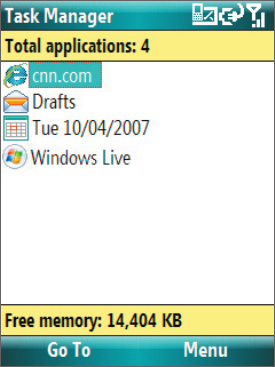
40 Managing your Phone
To enable optional phone services
1. Click Start > Settings > Phone.
2. Select the service you want to use and press ENTER.
3. Select desired options for the service and click Done.
Note You can also access the Phone settings by clicking Settings > Phone on the Comm Manager screen.
4.2 Adding and Removing Programs
Before you purchase additional programs for your phone, make sure that they are compatible for Windows
Mobile® 6 Standard operating system.
To add programs
1.
Download the program to your PC (or insert the disc that contains the program into the CD drive of your
PC). You may see a single *.exe file, a *.zip file, a Setup.exe file, or several versions of files for different
device types and processors. Be sure to select a program designed for your phone and processor type
.
2. Read the installation instructions that come with the program.
3. Connect your phone to the PC and then double-click the *.exe file.
To remove a program
Programs that are pre-installed on the phone cannot be removed.
1. On the Home screen, click Start > Settings > Remove Programs.
2. Scroll to the program to remove and click Menu > Remove.
4.3 Using Task Manager and Managing Memory
To see how much memory is available
1. On the Home screen, click Start > Settings > About.
2. Scroll down to Available Memory.
Use Task Manager
Task Manager allows you to view all the programs currently running on your phone in the form of a list.
To start Task Manager
• Click Start > System Tools > Task Manager.
On the Task Manger screen, click Menu to open
a list that lets you go to a specific program,
stop running programs, and view system
information.
To stop a running program, select a program on
the list and click Menu > Stop.
Task Manager
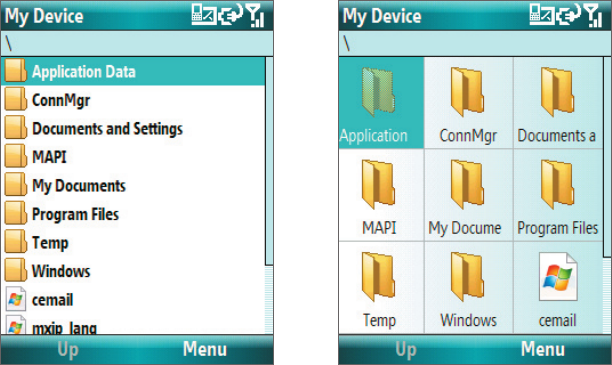
Managing your Phone 41
4.4 Managing and Backing Up Files
You can back up files to your PC using Windows Mobile Device Center or ActiveSync or copy files to a storage
card that is installed on your phone. You can also efficiently manage your files and folders using File Explorer
installed on your phone.
To copy files using Windows Mobile Device Center/ActiveSync to the PC
1. Connect your phone to your PC.
2. In Windows Mobile Device Center, click File Management > Browse the contents of your device.
Or
In ActiveSync on your PC, click Explore. This opens the Mobile Device folder for your phone.
3. Browse your phone for files that you want to copy to your PC.
4. Select and copy the files [Ctrl + C] and then paste them [Ctrl+V] to the destination folder in the PC.
Copying a file results in separate versions of a file on your phone and PC. Changes made to one file will not
affect the other since the files are not synchronized.
Use File Explorer
File Explorer provides many easy-to-use features for file and folder management.
To start File Explorer
• On the Home screen, click Start > File Explorer.
File Explorer operates in the following two views:
• List View
• Icons View
File Explorer displays the
entire file structure in
your phone’s memory. The
functions focus primarily on
folder management. When
initially started, File Explorer
is in List View by default.
To switch between views,
click Menu > View > Icons
or List.
File Explorer - List View File Explorer - Icons View

42 Managing your Phone
In File Explorer, click Menu to open a list
that lets you send or beam the file, view the
file’s properties, sort the files, and more.
Storage Card is only available if a microSD
is installed on your phone.
To send a file as an e-mail attachment
1. In File Explorer, select a file and click Menu > Send.
2. On the Messaging screen, select an e-mail account.
3. The file will automatically be attached to the new message. Specify the recipient and subject, and type
your message.
4. Click Send.
4.5 Protecting your Phone
You can protect your phone from unauthorized use by requiring a type of password called a simple PIN
(personal identification number) or a strong alphanumeric password.
To lock the keypad and keyboard
Locking the keypad and keyboard turns off their functionality. This is a helpful feature if, for example, the
phone is turned on and in your pocket, and you want to prevent accidental keypresses.
• On the Home screen, press and hold
( )
.
Once the keypad and keyboard are locked, the left soft key label changes to Unlock.
Tip To quickly lock the keypad and keyboard, press POWER briefly, and select Key lock from the Quick List.
Note You can still receive calls and make emergency calls when the keypad and keyboard are locked.
To unlock the keypad
• On the Home screen, click Unlock and press the key.
To enable the phone lock
1. On the Home screen, click Start > Settings > Security > Device lock.
2. Select Prompt if device unused for then select the amount of time for the phone to be inactive before
automatically locking.
3. Select the Password type then enter and confirm your password.
4. Click Done.
Note Once you configure the phone lock settings, you can enable the phone lock from the Quick List directly without
configuring the settings again.
Managing your Phone 43
To disable the phone lock
• Click Unlock then enter the password you have set to unlock your phone.
To encrypt files on the microSD card
• Click Start > Settings > Security > Encryption and select Encrypt files placed on storage cards.
4.6 Restarting your Phone
Restart your phone when a program is not performing properly or the phone is not responding to any
keypresses.
To restart the phone
1. Remove the battery.
2. Wait 3 seconds, then reinsert the battery and turn on your phone.
WARNING! If the phone is restarted while a program is running, any unsaved work will be lost.
4.7 Resetting your Phone
Resetting your phone will remove all the data from its memory and restore the phone back to the factory
default settings.
WARNING! As all of your data will be deleted, it is recommended that you back up your data first before resetting your
phone.
To reset your phone
1. Click Start > System Tools > Clear Storage.
2. Follow the on-screen instructions to reset the phone.
The phone will restart after it has been reset.
44 Managing your Phone

Chapter 5
Organizing Phone
Information
5.1 Contacts
5.2 Calendar
5.3 Tasks
5.4 Voice Notes

46 Organizing Phone Information
5.1 Contacts
Contacts is your address book and information storage for the people and businesses you communicate with.
If you use Outlook on your PC, you can synchronize contacts between your phone and PC.
Create a contact on your phone
To create a new contact on your phone
1. On the Home screen, click Start > Calls > Contacts > New.
2. Enter information for the new contact.
• To easily identify who is calling you, you can assign a custom ring tone to each contact. To assign a
custom ring tone, scroll down to and click Custom ring tone and select the ring tone you want.
• To assign a picture to a contact, scroll down to Pictures and click Select a picture and select the
picture you want. To remove the picture, click Menu > Remove Picture.
3. Click Done.
Tip If someone who is not in your list of contacts calls you or sends you a message, you can quickly create a contact
from Call History or from the message by clicking Menu > Save to Contacts.
Edit and call a contact
To view and edit a contact’s information
1. On the Home screen, click Start > Calls > Contacts.
2. Select the contact whose information you want to view or edit and click Menu > Edit.
3. When finished making changes, click Done.
To call a contact from the contact list
1. On the Home screen, click Start > Calls > Contacts.
2. Select the contact to call and press TALK ( ). The contact’s default phone number is dialed.
Tip To call a phone number other than the default, click the contact, scroll to the number you want to dial, and press
TALK ( ).
Find a contact
To find a contact
1. On the Home screen, click Start > Calls > Contacts.
Note If you are not in Name view, click Menu > View By > Name.
2. Do one of the following:
• Begin entering a name or phone number of the contact until the contact is displayed. When you
press a key, such as 5, you find first and last names that begin with J, K, and L, as well as phone
numbers that start with 5. The next key you press continues to narrow the search.
• If you have assigned categories (e.g. Business) to your Outlook contacts, you can filter the contact list
by categories. In the contact list, click Menu > Filter and then click a category. To show all contacts
again, select All Contacts.
• If you have entered information under Company for your Outlook contacts, you can quickly locate
the contacts that work for a specific on your phone. In the contact list, click Menu > View By >
Company. Click the company to see the contacts who work there.
Organizing Phone Information 47
Share contact information
To beam contact information to another device via Bluetooth
1. On the Home screen, click Start > Calls > Contacts and then select the contact whose information you
want to beam.
2. Click Menu > Send Contact > Beam.
3. Select the device where you want to beam the contact details to and click Beam.
Note Before you can beam, make sure that Bluetooth along with its Visibility is activated on your phone and the target
mobile device. For more information, see “Bluetooth” in chapter 8.
To send contact information via a text message
1. On the Home screen, click Start > Calls > Contacts and then select the contact whose information you
want to send.
2. Click Menu > Send Contact > Text Messages. Select the contact information that you want to send
and click Done.
3. In the new text message, enter the mobile phone number of the person to whom you are sending the
contact information to and click Send.
5.2 Calendar
Use Calendar to schedule appointments, including meetings and other events. If you use Outlook on your PC,
you can synchronize appointments between your phone and PC.
Create a personal appointment
To set Calendar options
1. On the Home screen, click Start > Calendar.
2. Click Menu > Tools > Options.
3. Scroll through the available settings and set your desired default options.
4. Click Done.
To schedule an appointment
1. On the Home screen, click Start > Calendar.
2. Click Menu > New Appointment.
3. Enter information about the appointment.
• To schedule an all-day event, in End time, select All day event.
• To make the appointment recurring, click Occurs.
4. Click Done.
View your appointments
To view your schedule
You can view your schedule in three different views: Month, Week, and Agenda.
1. On the Home screen, click Start > Calendar.
2. Click the left SOFT KEY or click Menu and choose the view you want.
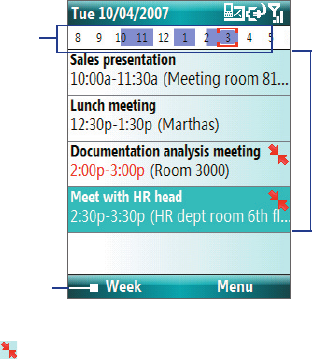
48 Organizing Phone Information
Highlighted areas
represent time segments
that have scheduled
appointments.
Click to change the view.
Click an item to view
the details of the
appointment.
Agenda View
An appointment with the icon indicates that the scheduled appointment has a conflict with one or more
existing appointments.
Send appointments
To send a meeting request
You can send meeting requests via e-mail to persons that use Outlook or Outlook Mobile.
1. Click Start > Calendar.
2. Schedule a new appointment and then scroll down to Attendees and click No Attendees.
Click Add Required Attendee or Add Optional Attendee to add the contacts you want to send the
meeting request to.
Note You can only specify if an attendee is required or optional if your phone is connected to a Microsoft
Exchange 2007 server. Otherwise, all attendees are designated as required. For more information,
see chapter 7.
3. Choose the contact(s) you want to send the meeting request to and click Select.
Note To remove an attendee from the list, select the attendee and click Menu > Remove Attendee.
4. On the New Appointment screen, click Done. The meeting request is sent out.
Note When attendees accept your meeting request, the meeting is automatically added to their schedules. When their
response is sent back to you, your calendar is updated as well.
5.3 Tasks
Use Tasks to keep track of things you need to do.
To create a task
1. On the Home screen, click Start > Accessories > Tasks.
2. Click Menu > New Task.
3. Enter the necessary task information and click Done.
• Set a Priority for the task. This item can be referenced when sorting tasks.
• Enter a Start date and Due date if the task starts and ends at a specific time.
• Enter a Reminder if you want to be notified if the task is due.
• Enter the Categories (you can set more than one) that best describes the task. This item can be
referenced when filtering tasks.
Organizing Phone Information 49
Notes
• You can synchronize information on your phone with your PC to keep your task list up to date in both locations.
• If you create a new task with a reminder on your PC and then synchronize tasks with your phone, the reminder will
play at the time that was set on your PC.
To locate a task
1. On the Home screen, click Start > Accessories > Tasks.
2. In the task list, do one of the following:
• To sort the list, click Menu > Sort by, and click a sort option.
• To filter the list by category, click Menu > Filter, and click the category you want displayed.
To mark a task as completed
1. On the Home screen, click Start > Accessories > Tasks.
2. Select the task, and click Complete.
5.4 Voice Notes
Use Voice Notes to create short voice recordings. Voice notes are included in the All Notes list and are named
consecutively (Recording1, Recording2, and so on).
To create a voice note
1. On the Home screen, click Start > Accessories > Voice Notes.
2. Hold the phone’s microphone near your mouth.
3. Click Record and say your voice note.
4. Click Stop to stop recording a voice note.
To delete a voice note
1. On the Home screen, click Start > Accessories > Voice Notes.
2. Select the voice note to delete.
3. Click Menu > Delete.
4. Click Yes.
Tip If you delete a voice note that has a default name, such as Recording1, this name becomes available for a new
voice note.
To listen to a voice note
1. On the Home screen, click Start > Accessories > Voice Notes.
2. Select the voice note to play, and press ENTER.
Tip To stop listening to the voice note, click Stop while the voice note is playing.
To use a voice note as a ring tone
1. On the Home screen, click Start > Accessories > Voice Notes.
2. Select the voice note, and click Menu > Set As Ringtone.
50 Organizing Phone Information

Chapter 6
Exchanging Messages
6.1 Messaging
6.2 Text Messages
6.3 MMS Messages
6.4 Setting Up E-mail Accounts
6.5 E-mail Messages
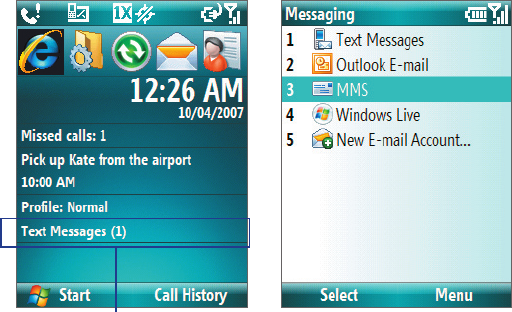
52 Exchanging Messages
6.1 Messaging
Messaging is where all of your e-mail, text message, and MMS accounts are located. When you receive a new
message, you can open that particular message from the Home screen. Simply scroll to the row where the
new message is and click it
To access your message accounts, click Start > Messaging and then click the account you want to open.
New message Messaging screen
While in a messaging account’s main screen, click Menu > Tools > Switch Accounts to switch to another
message account.
To change message account settings
• On the Messaging screen, select the message account whose settings you want to change and click
Menu > Settings.
• On a message account’s message list, click Menu > Tools > Options.
6.2 Text Messages
Send short text messages up to 160 characters long to other mobile phones. For quicker and easier typing,
use the sliding keyboard to enter your message.
To compose and send a text message
1. On the Home screen, click Start > Messaging.
2. Select Text Messages and click Select.
3. Click Menu > New.
4. Enter the mobile phone number of one or more recipients, separating them with a semicolon (;). To
access phone numbers from Contacts, in To, press ENTER and select a recipient from the list.
5. Enter your message. You can enter up to 160 characters in one message.
6. Click Send.
Tips
• To cancel the text message, click Menu > Cancel Message.
• If you want to know if your text message was received, before sending the message, click Menu > Message Options
and select Request message delivery notification.
• To always receive a notification, click Menu > Tools > Options > Account Settings in the text message list, and click
the Request delivery notifications check box.
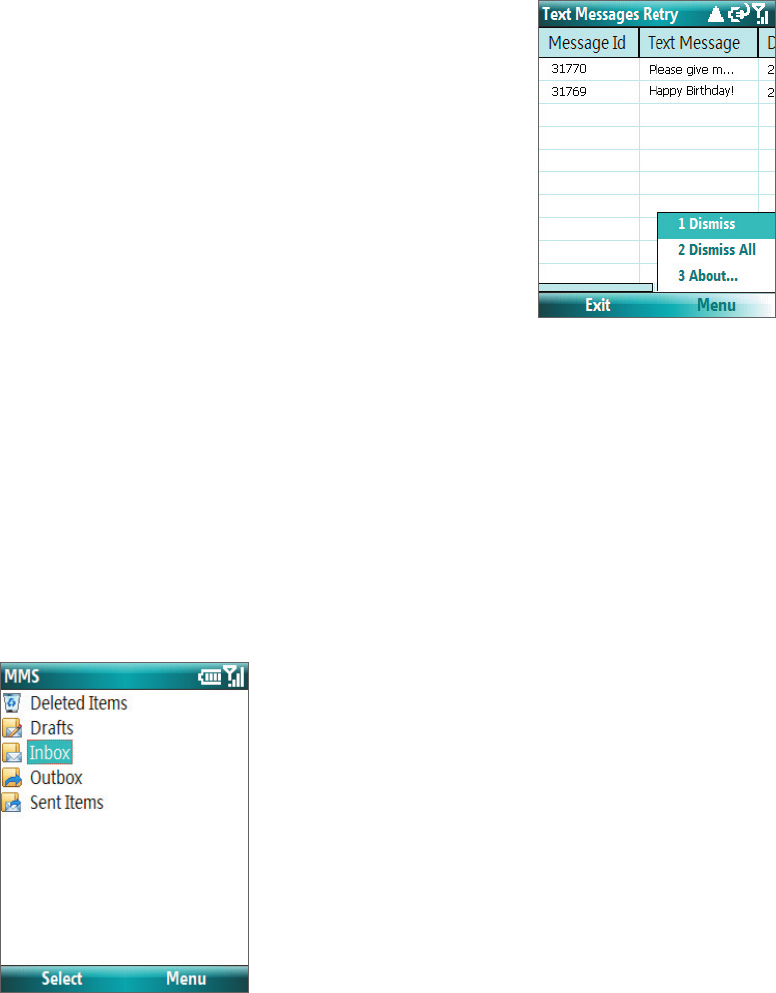
Exchanging Messages 53
To receive a text message
Text messages are automatically received when the phone function is turned on. When the phone is turned
off, text messages are held by your wireless service provider until the next time the phone is turned on.
To reply to or forward a text message
• Select the message and click Menu > Reply, Menu > Reply All, or Menu > Forward.
• Open the message and click Reply, Menu > Reply All, or Menu > Forward.
To automatically resend text messages that failed delivery
If text messages were not successfully sent due to network
problem or loss of signal coverage, they will be queued in
the Text Messages Retry program and automatically resent.
While text messages remain queued, you can choose to
delete some or all of them by following these steps:
1. Click Start > Text Messages Retry.
2. Do one of the following:
• To delete a text message, select the message then
click Menu > Dismiss.
• To delete all queued text messages, click Menu >
Dismiss All.
6.3 MMS Messages
Creating and sending Multimedia Message Service (MMS) messages to your friends and family is fun and easy.
To access MMS
• On the Home screen, click Start > Messaging > MMS.
To access MMS message folders
• Click Start > Messaging > MMS, then click Menu > Folders.
MMS Message Folders

54 Exchanging Messages
Edit MMS settings
When you purchase your phone, it is already preset with your wireless service provider’s MMS server settings.
If you accidentally lost the preset settings or you changed to another wireless service provider, follow the
steps below to configure MMS settings.
To configure MMS settings
1. On the Messaging screen, select MMS and click Menu >
Settings to open the Preferences screen.
2. Select or clear the provided check boxes according to your
needs.
3. On the Preferences screen, click Menu > MMSC Settings to
access Multimedia Messaging Service Center (MMSC) settings.
4. Check if your phone is preset with MMS server settings.
If there are no preset settings, click Menu > New on the MMSC
Settings screen and enter the needed information you see on
the screen. You can get the information from your wireless
service provider:
5. Click Done.
The MMS server settings will then be added as an entry on the MMS Configuration screen.
Note If you add several MMS service providers to the MMSC Settings screen, you can choose one as your default MMS
provider. Select the MMS provider’s name in the list, then click Menu > Set as Default.
Create and send MMS messages
You can compose MMS messages in a combination of various slides, where each slide can consist of a photo,
audio or video clip, and/or text.
Notes
• MMS is a charged service. In order to use MMS successfully, this has to be provisioned on your mobile account. Please
contact the wireless service provider to have this provisioned as part of your calling plan.
• Make sure the size of the MMS is within the limits of the wireless service provider if sending to another mobile phone
user or sending to an e-mail address.
To start composing an MMS message
1. On the Home screen, click Start > Messaging > MMS > Menu
> New.
2. In To, enter the recipient’s phone number or e-mail address .
3. In Subject, enter a subject for your message.
4. Click Insert Picture/Video to select a photo or video clip from
the Select Media screen and insert it.
To capture a new photo or video, click Menu > Capture
Picture/Video.
Tip After inserting an MMS message element, press NAVIGATION right to
add a new slide.
5. Click Insert Text to enter text for your MMS message.
To insert predefined text or emoticons, click Menu > My Text
or Insert Emoticon.

Exchanging Messages 55
6. Click Insert Audio to insert an audio clip. Select an audio clip on the Select Audio screen.
To record a new audio clip, click Menu > Capture Audio
7. Click Send to send the message.
Notes
• To send a copy of this message to others, access Cc and Bcc by clicking Menu > Options > Send Options.
• To remove the photo, text, or audio, select the item and press ( ).
View and reply to MMS messages
To receive MMS messages
• On any MMS message folder screen, click Menu > Send/Receive.
By default, messages are automatically downloaded to your phone.
To view an MMS message
You can view MMS messages in several ways.
• Press ENTER to view and play the message on your phone. Click Pause or Menu > Stop to pause or stop
the playback of the message.
• Click Menu > Object View to see a list of files included in the message. To open a file, select it and click
Open. To save a file, select it, and click Save, Menu > Save Audio, or Menu > Save Photo.
• View each slide included in the message by clicking Menu > Next.
To reply to an MMS message
• Click Menu > Reply > Reply to reply to the sender of the message, or click Menu > Reply > Reply All
to reply to all persons listed in the To and CC boxes of the message. Click Menu > Reply > Forward to
forward the message to someone else.
6.4 Setting Up E-mail Accounts
Before you can send and receive e-mail, you need to set up your e-mail account on your phone. You can set
up the following types of e-mail accounts on your phone:
• Outlook e-mail that you synchronize with your PC or your company’s Exchange Server
• Internet e-mail account that you have from an Internet Service Provider (ISP)
• Work account that you access using a VPN connection
• Windows Live Mail
• Other web-based e-mail accounts such as Gmail, Yahoo! Mail, etc.
Set up your phone to synchronize Outlook e-mail with the computer
If you have installed the synchronization software on your PC and created a partnership with your phone,
then your phone is ready to send and receive Outlook e-mail. If you have not yet installed the synchronization
software nor created a partnership, please do so by following the procedures in chapter 3.
Tip To set up your company e-mail account so that you can access Outlook e-mail messages wirelessly, you must set up
your phone to synchronize via a wireless LAN or over-the-air connection with your company’s Exchange Server. For
more information about synchronizing with your company e-mail server, see chapter 7.
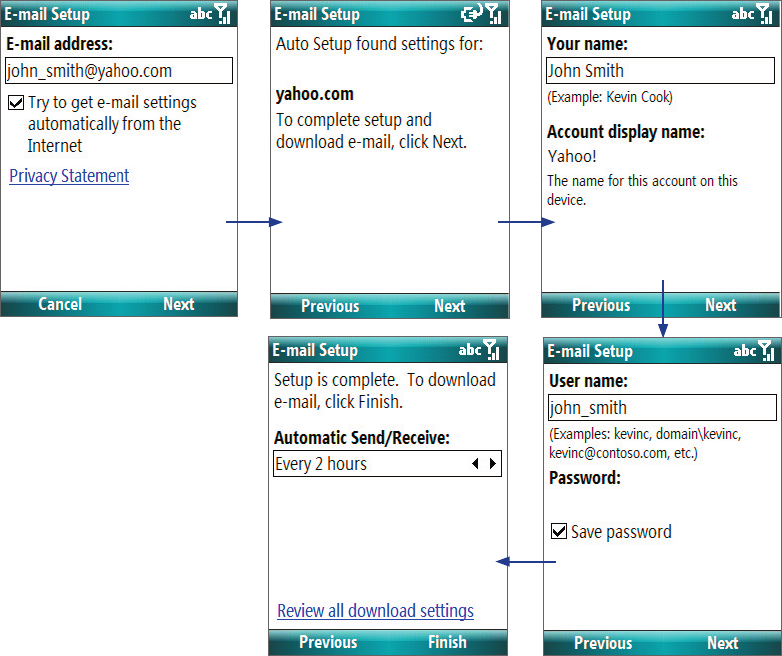
56 Exchanging Messages
Set up a new e-mail account
You can easily set up an e-mail account that you have with an Internet service provider (ISP), a web-based e-
mail or an account that you access using a VPN server connection (typically a work account) on your phone.
1. On the Home screen, click Start > Messaging > New E-mail Account.
2. In E-mail address, enter the e-mail address for this account.
3. Select Try to get e-mail settings automatically from the Internet and click Next.
4. If Auto Setup is successful, click Next to move on to the next screen.
5. In Your name, enter your display name for e-mail messages while in Account display name, enter a
name for the account that should appear on the Messaging screen. Then, click Next.
6. The User name field automatically gets populated. Select Save password and click Next.
If Auto Setup is unsuccessful, contact your ISP or network administrator for the settings.
Note The domain name is not required for an account with an ISP but may be required for a work account.
7. Once setup is complete, click Finish to download e-mails.
Note You can view e-mail download settings by clicking Review downand settings. To configure e-mail download
settings, click the Automatic Send/Receive box.
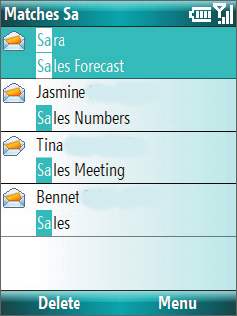
Exchanging Messages 57
6.5 E-mail Messages
After setting up e-mail accounts on your phone, you can start sending and receiving e-mail messages.
Create and reply to e-mails
To compose and send an e-mail
1. Click Start > Messaging then select an e-mail account.
2. Click Menu > New.
3. Enter the e-mail address of one or more recipients, separating them with a semicolon. To access e-mail
addresses stored in Contacts, click To.
4. Enter a subject and compose your message. To quickly add common messages, click Menu > My Text
and click a desired message.
5. Click Send.
Tips • To set the priority, click Menu > Message Options.
•
If you are working offline, e-mail messages are moved to the Outbox folder and will be sent the next time you connect
.
To add an attachment to an e-mail
1. In the message that you are composing, click Menu > Insert and click the item you want to attach:
Picture, Voice Note, or File.
2. Select the file you want to attach, or record a voice note.
View and reply to e-mails
When in an e-mail account, press and hold 0 (zero) to open a shortcut list of often-used commands. Press and
hold the shortcut key to execute the command.
To filter the Inbox message list
Filter the e-mail messages in your Inbox to only
display the e-mails that contain the sender or
e-mail subject you are searching for.
Enter the sender name or e-mail subject you
want to look for using the keypad or keyboard.
As you press keys, the list narrows down to the
conditions you set.
For example, pressing “S” then “A” narrows the
list to only the e-mails that contain sender
names and e-mail subjects that start with “SA.”
To read incoming messages
By default, only the first few kilobytes of a message are shown when you open and read an incoming
message. To read the whole message, do one of the following:
• Scroll down to the end of the message and click Get the rest of this message; or
• Click Menu > Download Message.
58 Exchanging Messages
To download an attachment
In an open message with an attachment to download, click the attachment. If there is more than one
attachment, click the other attachments to download them. You can directly open the file in the associated
program after you download them by clicking the attachment again.
To reply to or forward an e-mail
1. Open the message and click Menu > Reply > Reply, Reply All, or Forward.
2. Enter your response. To quickly add common messages, click Menu > My Text and choose a desired
message.
3. Click Send.
Tips • To see more header information, scroll up.
• To always include the original message, from the list view, click Menu > Tools > Options > Sending, and select the
Include copy of original message when replying to e-mail check box.
• In the Outlook E-mail account, you will send less data if you do not edit the original message. This may reduce data
transfer costs based on your rate plan.
To view and reply to HTML e-mails
You can receive, view and reply to HTML e-mails from any type of e-mail account. The HTML format is retained,
without layout shifting or resizing.
Note HTML e-mail support in Outlook Mobile is available only if your company is using Microsoft Exchange Server 2007.
1. Set the message format to HTML. To find out how to set the message format, see “Customize e-mail
settings”.
2. Click Start > Messaging, select your e-mail account, and open an HTML e-mail that you received.
3. Click Get the rest of this message that’s shown at the bottom of the message to download the whole
message.
4. Scroll up (if needed) and click Click to scroll right to be able to scroll sideways and get a complete
horizontal view of the message.
Note If images do not immediately appear, click Internet pictures blocked > Download Internet pictures.
5. Click Reply or click Menu > Reply and choose whether to reply to the sender(s) or forward the
message.
6. Enter your response and click Send.
Tip E-mail can contain hyperlinks to Web pages.
Send and download e-mails
The manner in which you send and receive e-mails depends on the type of e-mail account you have.
To send and receive e-mail for an Outlook account
1. Click Start > ActiveSync.
2. Connect your phone to your PC.
Otherwise, connect wirelessly if you are synchronizing Outlook e-mail with your company e-mail
server. For more information, see chapter 7.
3. Synchronization automatically begins, and your phone sends and receives Outlook e-mail.
Tip You can also manually synchronize anytime by clicking Sync in ActiveSync or Menu > Send/Receive in Outlook
Mobile.
Exchanging Messages 59
To send and receive e-mail for a POP3/IMAP4 account
If you have an e-mail account with an ISP or a work account that you access using a VPN server connection,
you send and receive messages through a remote e-mail server. Before sending and downloading messages,
you first need to connect to the Internet or your corporate network.
1. Click Start > Messaging and click your POP3/IMAP4 e-mail account.
2. Click Menu > Send/Receive. The messages on your phone and e-mail server are synchronized: new
messages are downloaded to the phone Inbox folder, messages in the phone Outbox folder are sent,
and messages that have been deleted from the server are removed from the phone Inbox folder.
Customize e-mail settings
To change the download size and format for Outlook e-mail
1. Disconnect your phone from the computer.
2. Click Start > ActiveSync.
3. Click Menu > Options, select E-mail, then click Settings.
4. On the E-mail Sync screen, set the Download size limit and Message format.
5. Close ActiveSync and reconnect your phone to the computer.
To change the download size and format for POP3/IMAP4 e-mail
1. On the POP3/IMAP4 e-mail message list, click Menu > Tools > Options > Account Settings.
2. Keep clicking Next until you reach the last screen where the first item is Message format.
3. Set the Message format and Message download limit.
4. Click Finish.
To exclude your e-mail address when replying to all
When you reply to all the recipients of an Outlook e-mail, your own e-mail address will also be added to the
recipient list. Customize ActiveSync so that your e-mail address will be excluded from the recipient list.
1. In ActiveSync on your phone, click Menu > Options.
2. Select the E-mail information type and click Settings.
3. Click Menu > Advanced.
4. In the My e-mail addresses text box, enter your e-mail address.
5. Click Done.
60 Exchanging Messages